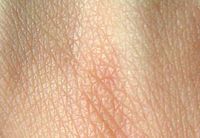
Photo from wikipedia
In vitro three-dimensional (3D) skin tissue models are critical tools in advancing our understanding of basic skin physiology and function as well as in specific applications such as toxicity testing… Click to show full abstract
In vitro three-dimensional (3D) skin tissue models are critical tools in advancing our understanding of basic skin physiology and function as well as in specific applications such as toxicity testing of dermatological compounds. However, the utilization of such skin models is often limited by the structural instability of the construct, lack of physiologically relevant features and weak barrier function. In this review, we highlight the current research efforts in hydrogel biomaterial selection and scaffold design that allow for maturation of engineered skin in vitro, with special emphasis on matured full-thickness (including epidermal and dermal compartments) skin. The different types of scaffold biomaterials, broadly categorized as natural, synthetic, or composite will also be discussed. At the same time, we will outline strategies for next-generation biomimetic skin templates incorporating skin appendages or perfusion systems that can more closely reflect the native skin environment. STATEMENT OF SIGNIFICANCE: In vitro 3D human skin models are critical tools in advancing our understanding of skin physiology and function. Many of the existing reconstructed models are limited in terms of structure and complexity, thus failing to recapitulate native human skin. In order to address this, hydrogels have been identified as useful scaffold materials for fabricating the dermal equivalent of 3D skin models, allowing for greater flexibility and control in scaffold properties and cellular incorporation. This review aims to provide a critical discussion of the biomaterial selection and design strategies in the construction of hydrogel-based full-thickness skin equivalents. At the same time, we will offer insights into the future developments and technological advances which can accelerate the progress in this field.
Journal Title: Acta biomaterialia
Year Published: 2022
Link to full text (if available)
Share on Social Media: Sign Up to like & get
recommendations!